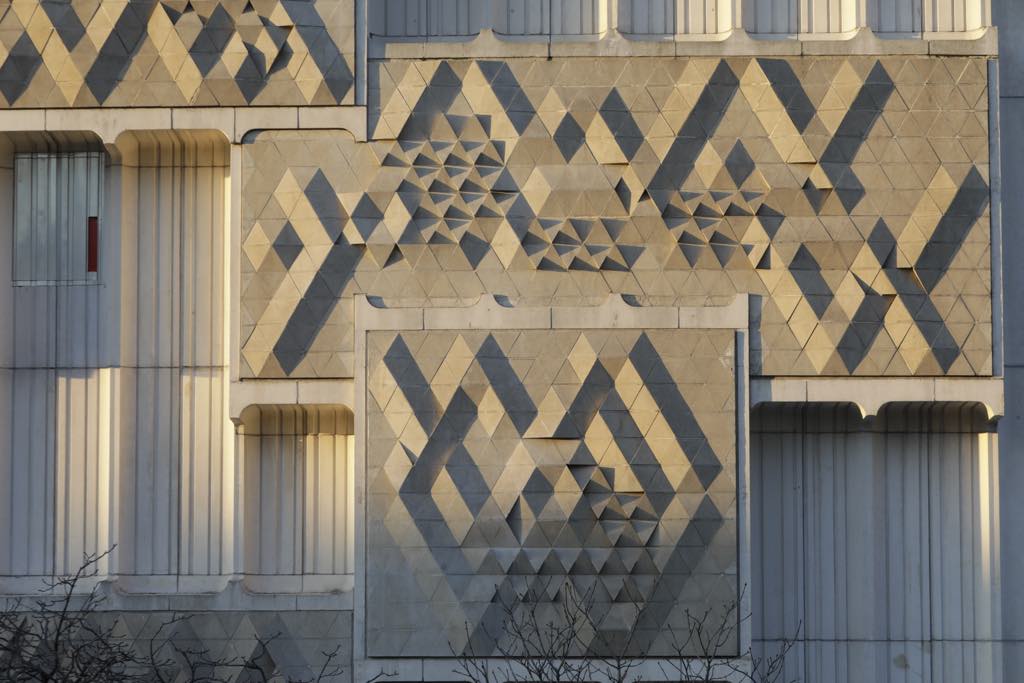Paris’s newly renovated Musée de la Poste (Post Office Museum) is far more than just heaven for philatelists (although it certainly is that, with examples of every stamp ever produced in France: 5,300 of them since 1849). In the tradition of other great French museums devoted to a specific field, like the Monnaie de Paris (recently renovated) and Musée de la Marine (closed for renovation), it offers everything you ever wanted to know about the French Post Office but didn’t think to ask. And it does it in a very entertaining fashion.

The interior of the brutalist (yet pleasing to look at) building, located next to the Gare de Montparnasse, dating from 1973, has been completely redesigned and reorganized “to let the light in,” by the firm Jung Architectures and is now eco-friendly. On the facade are sculptures by Robert Juvin that are meant to evoke postage stamps.
The museum now has three exhibition levels united by a central atrium with a “totem pole,” from which are suspended models of the different vehicles that have been used to deliver the mail in France. The real things are on display in the galleries: from horse-drawn buggies and a creaky bicycle like the one used by Jacques Tati in Jour de Fête (The Big Day) to today’s electric tricycles for use in cities and drones for delivery to remote locations.
The museum offers quite a lot of detail about the creation of a postage stamp, including letters on the subject, the artist’s original sketches, and the various stages in its development. In 1961, then-Culture Minister André Malraux started commissioning stamp designs from well-known artists rather than just reproducing an existing work (by Matisse or Cézanne, for example). Among those asked to create a stamp were Joan Miró, Pierre Soulages and Arman.
Then there are letterboxes from around the world, all the different French boxes, and boxes decorated by artists, such as Skall’s “Boîtes de Lumière” (1995), two mailboxes dressed in glitter, one red and one gold.
The top floor is devoted to the surprisingly interesting history of the French post office, stretching back to the 15th century. We learn about the life of the workers and the uniforms they wore (from smocks to military-like suits and képis) and the machinery they used and how both evolved over time. A whole section is devoted to the airplanes used to deliver the mail (the post office was instrumental in the development of aviation in France; and Antoine de Saint-Exupéry, author of Le Petit Prince, was one of the pioneers of international postal flight).
We learn that the post office was one of the first major employers of women in France, especially during World War I, and les demoiselles de la poste are given their due here in photos and films of their stressful jobs as switchboard operators, for example.
Believe it or not, the French postal service even has an office employing 60 secretaries to respond to all letters addressed to Santa Claus (1.2 million in 2016). A number of examples are on display, many of them colorfully illustrated. One sad missive is from a seven-year-old girl who has to hide from her babysitter to write her letter asking Santa for an apartment so she and her “maman chérie,” who have been deserted by her father, can move out of the hotel they live in and “be happy.” I wonder how the post office responded to that one.
One Parisian particularity that is part of the lore of the city – mentioned often by Marcel Proust and featured in François Truffaut’s Baisers Volés (Stolen Kisses) – is the pneumatic system, which could sometimes deliver a letter, known as a “pneu” or “petit bleu,” in less than an hour through a network of 290 miles of tubes running through the sewer system. It went into service in 1866 and only ceased to operate in 1984, a victim of the fax machine.
This is only a glimpse of the hundreds of treasures on display at the new Musée de la Poste. Plan to spend many hours or, better yet, return often.
Favorite
Thank you for the review of the Post office museum – it sounds fascinating!
Heidi:
Thank you for this amazing article. I collect French stamps but did not know this museum existed. I will definitely visit next time I am in Paris.
When I was a teenager my Dad bought me a French postage album.
He went to France often and would bring me back stamps each time he went to Paris. I stopped collecting but would like to buy French stamps again. Does the museum have a catalogue?
Glad you enjoyed it! You can find the catalogue on this page: https://www.museedelaposte.fr/boutique
I’m a member of the American Philatelic Society. French stamps are my favorites! So many of them are great works of art and, after the “classical” era, the centering of French stamps became a model for all countries to emulate. My complete collection of French Antarctica and the Southern Territories is a highlight of my material. Your story is a reminder to me of just what it’ll take to really master French philately!
Used to go there regularly but slacked off as my mobility declined. Always came home with a packet of stamps for my Christmas letters..